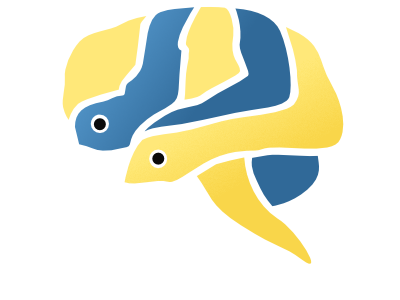eelbrain.plot.GlassBrain¶
-
class
eelbrain.plot.GlassBrain(ndvar, cmap=None, vmin=None, vmax=None, dest='mri', mri_resolution=False, mni305=None, black_bg=False, display_mode=None, threshold=None, colorbar=False, draw_cross=True, annotate=True, alpha=0.7, plot_abs=False, draw_arrows=True, symmetric_cbar='auto', interpolation='nearest', show_time=False, **kwargs)¶ Plot 2d projections of a brain volume
Based on
nilearn.plotting.plot_glass_brain().Parameters: - ndvar : NDVar ([case,] time, source[, space])
Data to plot; if
ndvarhas a case dimension, the mean is plotted. ifndvarhas a space dimension, the norm is plotted.- cmap : str
Colormap (name of a matplotlib colormap).
- vmin : scalar
Plot data range minimum.
- vmax : scalar
Plot data range maximum.
- dest : ‘mri’ | ‘surf’
If ‘mri’ the volume is defined in the coordinate system of the original T1 image. If ‘surf’ the coordinate system of the FreeSurfer surface is used (Surface RAS).
- mri_resolution: bool
If True the image is created in MRI resolution through upsampling. WARNING: it can result in significantly high memory usage.
- mni305 : bool
Project data from MNI-305 space to MNI-152 space (by default this is enabled iff the source space subject is
fsaverage).- black_bg : boolean. Default is ‘False’
If True, the background of the image is set to be black.
- display_mode : str
Direction of the cuts:
'x': sagittal'y': coronal'z': axial'l': sagittal, left hemisphere only'r': sagittal, right hemisphere only'ortho': three cuts in orthogonal directions, equivalent to'yxz'
Possible values are: ‘ortho’, ‘x’, ‘y’, ‘z’, ‘xz’, ‘yx’, ‘yz’, ‘l’, ‘r’, ‘lr’, ‘lzr’, ‘lyr’, ‘lzry’, ‘lyrz’. The default depends on the data: ‘lyr’ if both hemispheres are present, ‘xz’ if only one is.
- threshold : scalar | ‘auto’
If a number is given, values below the threshold (in absolute value) are plotted as transparent. If
'auto'is given, the threshold is determined magically by analysis of the image.- colorbar : boolean
If True, display a colorbar on the right of the plots.
- draw_cross: boolean
If draw_cross is True, a cross is drawn on the plot to indicate the cut plosition.
- annotate: boolean
If annotate is True, positions and left/right annotation are added to the plot.
- alpha : float between 0 and 1
Alpha transparency for the brain schematics
- plot_abs : bool
Plot the maximum intensity projection of the absolute value (rendering positive and negative values in the same manner). By default, (
False), the sign of the maximum intensity will be represented with different colors. See examples.- draw_arrows: boolean
Draw arrows in the direction of activation over the glassbrain plots. Naturally, for this to work
ndvarneeds to contain space dimension (i.e 3D vectors). By default it is set toTrue.- symmetric_cbar : boolean | ‘auto’
Specifies whether the colorbar should range from -vmax to vmax or from vmin to vmax. Setting to ‘auto’ will select the latter if the range of the whole image is either positive or negative. Note: The colormap will always be set to range from -vmax to vmax.
- interpolation : str
Interpolation to use when resampling the image to the destination space. Can be “continuous” (default) to use 3rd-order spline interpolation, or “nearest” to use nearest-neighbor mapping. “nearest” is faster but can be noisier in some cases.
- title : str | bool
Figure title. Set to
Trueto display current time point as figure title.- …
Also accepts General layout parameters.
Notes
The brain overlay assumes coordinates in MNI152 space (see The MNI brain and the Talairach atlas). For data with different coordinates, the brain shape overlay will not be accurate.
Methods¶
add_hline(self, y[, axes]) |
Draw a horizontal line on one or more axes |
add_hspan(self, bottom, top[, axes]) |
Draw a horizontal bar on one or more axes |
add_vline(self, x[, axes]) |
Draw a vertical line on one or more axes |
add_vspan(self, xmin, xmax[, axes]) |
Draw a vertical bar on one or more axes |
butterfly(y[, cmap, vmin, vmax, dest, …]) |
Shortcut for a butterfly-plot with a time-linked glassbrain plot |
close(self) |
Close the figure. |
draw(self) |
(Re-)draw the figure (after making manual changes). |
draw_crosshairs(self[, enable]) |
Draw crosshairs under the cursor |
get_time(self) |
Retrieve the current time |
image(self[, name, format]) |
Create FMTXT Image from the figure |
link_time_axis(self, other) |
Link the time axis of this figure with another figure |
play_movie(self[, time_dilation]) |
Cycle through the time axis |
plot_colorbar(self[, label, label_position, …]) |
Plot a colorbar corresponding to the displayed data |
save(self, *args, **kwargs) |
Short-cut for Matplotlib’s savefig() |
save_movie(self[, filename, time_dilation]) |
Save the figure with moving time axis as movie |
set_name(self, name) |
Set the figure window title |
set_time(self, time) |
Set the time point to display |
set_xlabel(self, label[, ax]) |
Set the label for the x-axis |
set_xtick_rotation(self, rotation) |
Rotate every x-axis tick-label by an angle (counterclockwise, in degrees) |
set_ylabel(self, label[, ax]) |
Set the label for the y-axis |
